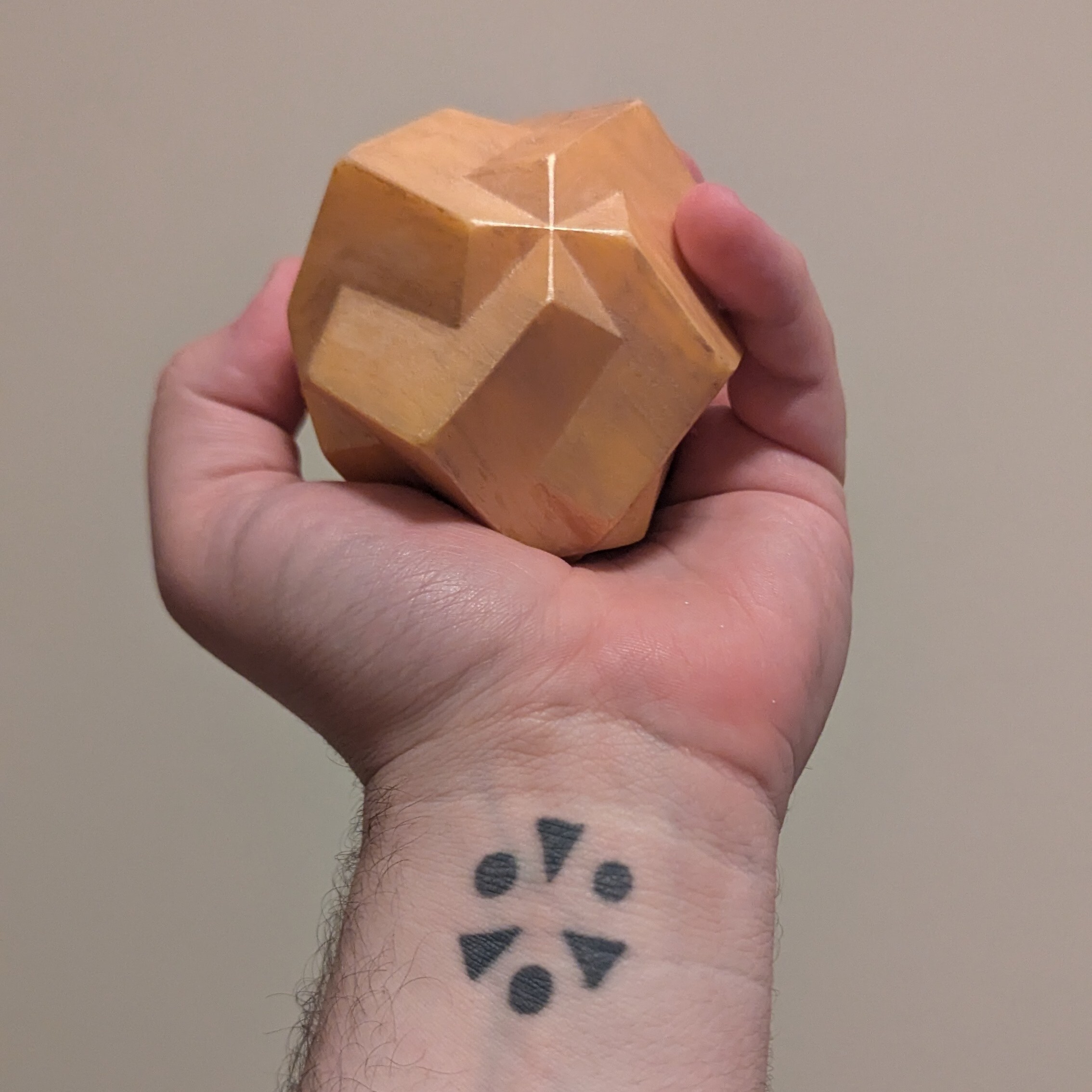Americans are still using monarchy units while the rest of the world is on freedom units.
Really though, the most ardent defence of USC units is fuelled by great amounts of Copium. The US Customary set of measurements is several independent systems of measurements which often radically different origins and sometimes irrational conversions, all stacked upon each other and dressed in a trench coat. For instance, the mile has Roman origins while the inch and foot were defined separately, much later, and with a lot of regional variation. The French foot was longer than the English foot, which is why Napoleon was listed as 5’2" tall while he was actually closer to 5’9", or 1.71 m, which was pretty average for the time.
Which one of these is more straightforward to calculate:
-
You are tasked with installing a rail along a 1 mile long bridge. You know you can use two half inch bolts to affix it every three feet. How many bolts do you need?
-
You are tasked with installing a rail along a 1,5 km long bridge. You know you can use two M12 bolts to affix it every metre. How many bolts do you need?
Conversions within dimensions in USC require you to memorise arbitrary conversion numbers. Conversions within dimensions in SI require you to move the comma a few spots.
Besides, if the US Customary system of units is so great, why did most of the world voluntarily switch to SI units?
Good example with the Bridge, it’s exact the point with the USC units, source of fatal errors.
I don’t like the bridge example because the values were chosen (intentionally or not) conveniently for metric. Change it to every 4 feet or 1.3 metres and it’s no longer convenient in either system. There are better examples that demonstrate the superiority of metric.
For example, pool cleaner says 1 unit per 10,000 gal or 40,000 L.
21’ diameter, 3’ tall. So ~1000 ft³. Multiply by 1728/231 for gallons.
7 m diameter, 1 m tall. So ~40 m³. Multiply by 1000 for litres.
If you’re curious where 1728/231 comes from, there are 12³ (1728) in³ for a ft³. Then the gallon is defined as 231 in³
-
Everything in America except building trades has transitioned to metric already.
Even our imperial units are defined in metric.
But… PLEASE don’t tell our citizens. It will all be fine as long as we don’t tell them!
This is exactly my experience. I’ve worked for four different manufacturing companies in the Midwest. Three of them were multi billion dollar companies. All four of those companies used metric almost exclusively.
Such a stupid misconception that is constantly reposted
I have to agree 100%. The slavish devotion of small brained regressive idiots to base 12 time keeping has bugged me for fucking ever. Swatch solved this decades ago, but people are too stuck in their “But this is what we’ve always used” bullshit mindset.
Fuck your decimal system. Dozenal is the most intuitive number system. Arithmetic is so much easier to learn in dozenal and you can even count higher on your hands if you use phalanges instead of fingers. Base 10 is a crap number system. It’s barely composite, it only has two prime factors.
Use binary. You can count super high on your fingers, arithmetic is as easy as it gets. Binary is the best number system.
Nah, readability is low and you can’t divide by three OR five easily. Binary has even fewer prime factors than decimal.
Base 12 is better than base 10. In an alternate universe we use it for everything and it’s a utopia. There is world peace and no one is hungry.
12 is evenly divisible by 2, 3, 4, and 6. 10 is only evenly divisible by 2 and 5.
(Fun fact, Tetris in that alternate universe doesn’t have the stupid Z and S Tetronimos. People are happy there.)
I’m basically forced to know the good way, and the American way.
Yanks stop trying to claim things as your own.
Metroids itt btfo, malding, fractionally mogged upon.
For anything construction-scale, all supplies sold in the US are based on 4x8’ sheet goods and 16-24" on-center framing. I also concede that king George the 74th’s foot length is more human-scale when dealing with large measurements: 20 feet vs 6096 mm. I still use metric when possible, however - I find it easier and more accurate.
For EVERYTHING else I’ve switched to using metric.
Context: I grew up in the US using imperial units and only pivoted to the metric system in 2020. If I grew up thinking in metric and building supplies/standards used it, it’d be superior in every way.
TL;DR I like my imperial/metric combo tape measure.
I get angry when hardware uses imperial units because I can’t use my metric tools, which are way the fuck easier. Who wants to use 5/8" when you can use 16?
6096 mm does sound really stupid when you could just say 6.096 m.
All plans use mm exclusively. Airport blueprints, for example, are in mm. At first blush it seems excessive, but it makes sense from a consistency & accuracy POV - 6.096m takes up 2 more characters than 6096 - they don’t even need to specify the units “mm”, because it is assumed, and anything else introduces room for error.
“Ok Bob, we’re going to build a runway, it needs to be 3,962,000 mm long”
I’m terrified of driving the day they move the US from miles to kilometers. People go well over the speed limit as it is. I can only imagine how many people would read the kilometer per hour speed limit as miles.
England still has their speed limits in mph and all road signs are in miles and yards…
I had never considered this before, but you’re absolutely right
There are (huge) costs to retooling production to move from imperial to metric. Even if a company wanted to make that move they’d have to transition in phases and will likely end up with additional equipment to maintain. There’s also significant training for workers (who will likely commit errors in the beginning) which will impact production. And what happens to the old equipment? I’d guess a significant portion of that would end up getting scrapped and landfilled.
@Zerush Too much hassle to change to metric
But if isn’t.
- start by putting metric units next to the SAE units in the labels
- Eventually people get used to the units and then you phase out the use of them.
All science and most of the mechanical engineering is done in metric already. If you have a car made in the last 20 years ask the fasteners are already metric. So it really isn’t that hard…
We already do that. Looking at a bottle of tea I drank earlier today and it says 16FL OZ (473mL) both units are labeled on most things.
Ford still uses SAE bolts/screws for door panels, but not always.I only keep metric sockets and wrenches in my box, but have to keep a 1/4" socket just for the random Ford I have to work on.
With that attitude it will be. Just because it’s a hassle does not mean it’s not worth doing.
My country
menfolk are fools.Perhaps I’m biased, but sometimes it’s easier to work in fractions. Also, setting room temp is objectively better in F. I can tell the difference between 74 and 75. That said, I’m also a scientist so I’m permitted these opinions.
No, you are not permitted these decisions because you are something.
Its still bias
deleted by creator
deleted by creator
There are 8000 linguistic systems in use today, about 90 calendars, a few hundred legal systems, a few hundred monetary systems, but Redditors fume at the thought that Planet Earth uses >1 convention for weights and distances
I really like Farenheit system for temperatures. 0 is really cold and 100 is really hot, but both survivable. It’s a human-centric system.
0C is the temperature that water freezes, which is good but temperatures more often go negative with that system. 100C is boiling so you’d be dead.
What’s so special about the 0 - 100 range? For either system, there’s temperatures that have significance.
-20 C is getting dangerously cold (wear all winter gear available if you must be outside for anything longer than brief durations).
-10 C is very cold (winter coat, gloves, hat).
0 C is freezing (winter coat necessary, gloves and hat optional).
10 C is chilly (winter coat unzipped, or jacket and sweater).
20 C is comfortable (t-shirt and pants).
22 C is about room temperature (shorts become viable above this).
30 C is hot (nude comfortable; minimize clothing).
40 C is getting dangerously hot (depending on humidity and personal heat tolerance) (clothing that protects from heat might be more desirable than minimising clothing).
F has finer whole number resolution for temperatures typically experienced by humans. Obviously C can be represented by decimals, but I tend to think whole numbers are clearer.
Personally I use C and metric for all my scientific work and F for representing outside temperature.
Edit: Phrasing
I honestly can’t say I need resolution finer than Celsius for air temperature. So many other factors have such bigger effects on the perceived temperature (humidity, UV index, if the sun is shining, wind speed, etc) that a granularity of 1°F doesn’t make sense to me.
Pool temperature, on the other hand, yeah, 1°F or 0.5°C resolution is perceptible.
I responded a few posts higher with more detail about this, but after teaching myself Celsius I actually prefer the lower resolution. A change of degree Celsius has more meaning than a change of degree Fahrenheit. (Also many, though not all, weather sources are using the Celsius values anyway and then converting and rounding them to Fahrenheit, so you don’t really get the benefit of that granularity.)
I really like Farenheit system for temperatures. 0 is really cold and 100 is really hot, but both survivable. It’s a human-centric system.
I used to make this argument, that Fahrenheit made more sense for weather, but I decided to be (somewhat) scientific about it and test the hypothesis (with a sample size of 1).
So I switched everything I own over to Celsius and set about teaching myself.
This was back in 2019, and here I am still using Celsius 5 years later. I like it a lot more than Fahrenheit.
A couple of major reasons: first, you don’t actually need the precision Fahrenheit gives you for weather. The difference between 68°F and 69°F is so small that degrees Fahrenheit have very little meaning. It was startling to me how quickly I came to understand the differences between degrees Celsius because they have a lower resolution. And of course you can always use half degrees if you need to, but honestly it’s fine without.
What I realized is that, very often, the temperatures that you see on weather reports or apps are really just the Celsius degree values converted and rounded. For example, you’re far more likely to see 68°F or 70°F rather than 69°F, since 20°C=68°F and 21°C=69.8°F. This isn’t true for every weather source, but it was still interesting.
But more importantly, 0 is freezing.
This never seemed like it mattered when I was using Fahrenheit. I know 32°F is freezing, if it’s below that it’s gonna be snowing instead of raining. But the first winter I experienced in Celsius was eye-opening.
I realized that temperatures below freezing in Fahrenheit never really meant much to me. This is sort of hard to explain, but while I knew they were progressively colder there wasn’t much specific understanding. That is, 23°F doesn’t really mean anything to me.
But -5°C? That instinctively meant something to me the very first time I experienced it in Celsius. That’s going to be as far below freezing as 5°C is above freezing. No math involved. Simple. Valuable. Obviously you can do the math to figure the same thing out in Fahrenheit, but with Celsius you don’t need to.
Once you get to know the numbers, it’s just as good as an other system of measurement, and I find I like it more for the weather than I like Fahrenheit.
I’ve read that it is more easily divisible than metric.
Divide a meter by 3 or 4 and get ugly numbers but a foot or yard divide by 3 or 4 quite cleanly. And so on.
Depending on your application this can be very helpful.
Divide a metre by 4 and you get 0.25 meters or 25cm
Dived a foot by 4 you get 3 inches.
Dived a yard by 4 you get 9inches
Metric here wins in my opinion.
Now let’s go by 3
1m by 3 is yes 33.3r not great but 1m is 100cm and that’s how it is.
1ft by 3 is 4 inches. Sure looks great now.
Except size resolution is far greater in metric in simple forms
Every inch is 2.54 cm obviously they dont round up nicely.
Once we have to go smaller than an inch we need 15/16s of a inch, smaller then a cm we drop down to mm.
10mm makes a cm.
In super practical terms i need a spanner, 16mm is to big, i get the 15 next.
5/8 is to big what do i get next?
(I know the answer)
Also another argument is well whats if you need half a mm etc we just use 0.5m or 0.7mm etc
Very small sizes for most everyone day to day.
Sure it’s not great breaking it too 0.whatever, but metric does it so much smaller as imperial made that jump to incorporate a size smaller then an inch.
1/4 inch is just 0.25 inches
Base 12 has factors: 1,2,3,4,6. Dividing by 5 is tricky.
Base 10 has factors: 1,2,5. Dividing by 3 is tricky.
I think this is it. The 5 factors instead of 3.
I also think there was something to do with fractions of an inch too. Like that divisibility was also an advantage of imperial.
Even these people who are screeching “decimal for everything!” in the thread still use dozenal for time, months, and cartons of eggs.
Meanwhile I’m bucking trends as an advocate of the dozenal metric system.
I was going to mention the base number issue but couldn’t be bothered, i had just only woken up
Try working in metric for any significant amount of time and you may change your mind.
Division no is the problem in one unit, inch, feet, etc, because use fraccions instead of decimls, but the problem is the conversion from inch, feet to others (yards, miles), which is the source of a lot of errors, like those from the Mars probes or some catastrophigs breaks of bridges in the past, apart of some problems in physics, because using for weught and mass the same unit. No, imperial are not human measures, never has been since humans count with 10 fingers.
Nothing against metric, but base-10 is a complete train wreck of a numbering system. Mathematics in general, and geometry in particular, are gorgeous and elegant in base 12.
Are you even a mathematician if you don’t calculate using the sexagesimal system?
Maybe, but imperial not even this, using absolute random units.
Do you people legit believe people used feet&inches, pounds&ounces for over 2000 years for no reason?
And also ells, rods, cubits, paces, furlongs, oxgangs, lots, batmans… all with subtly different regional definitions (with regions sometimes as small as one village).
People used loosely defined measurements based on things like their own body parts or how much land they guessed their ox could plow on an average day. Things like mathematical convenience or precision were not all that important; being able to measure (or estimate) without tools was.














